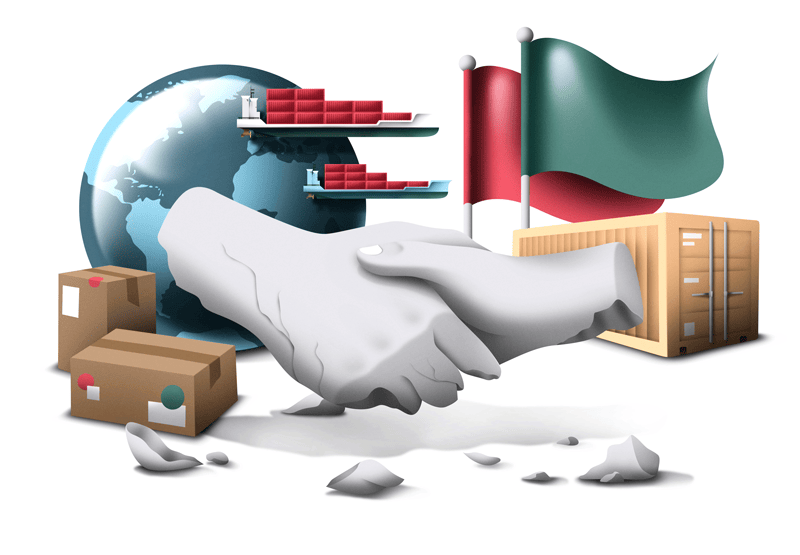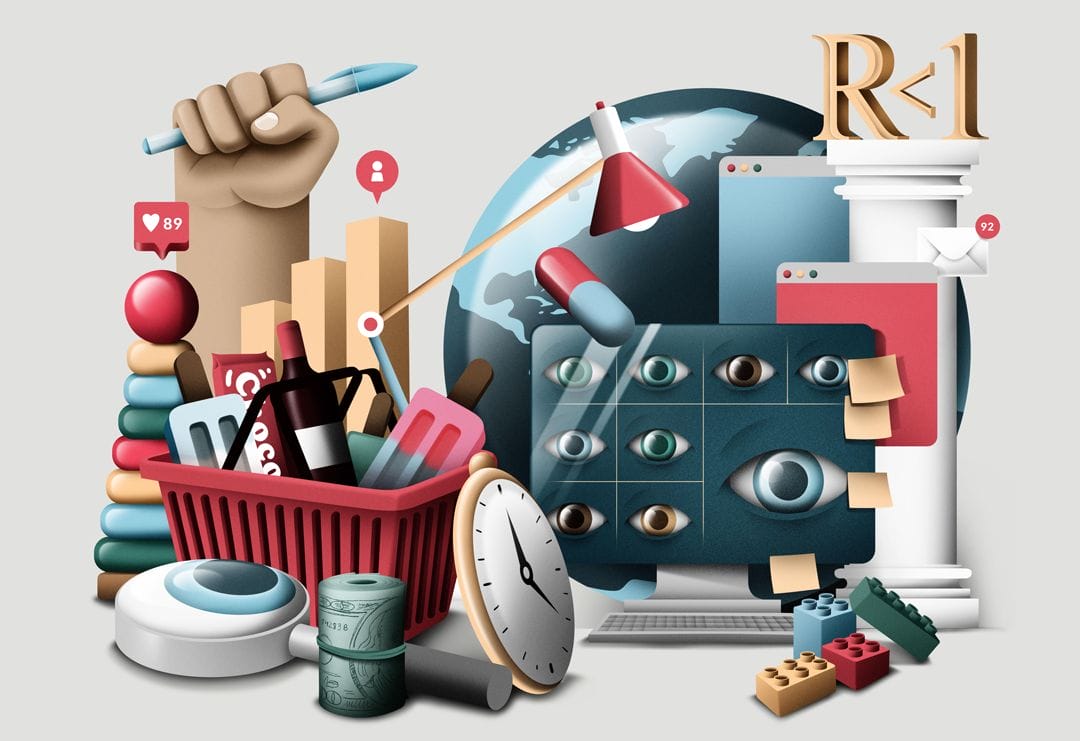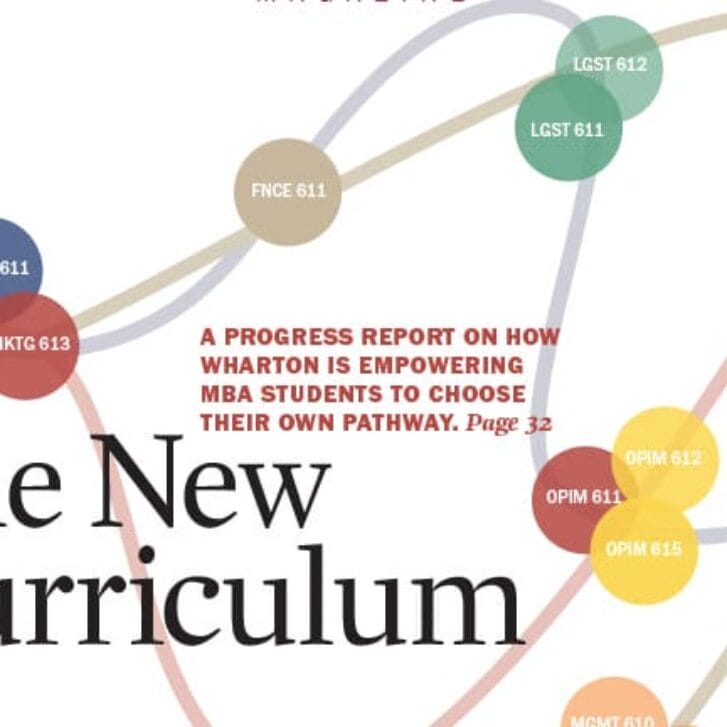Preparing for the Next Financial Crisis
Rethinking loan programs and considering the impact of remote work on Wall Street
 Hopefully, the risk of contagion returns to where it was before, we return to working the way we did before, and the long-run effect of thispandemic is what we learn from it. There’s been plenty to learn — who knew how to pause an economy? Not that we really know now, but still, these months of hard knocks and battlefield medicine should help us prepare better for the next hibernation.
Hopefully, the risk of contagion returns to where it was before, we return to working the way we did before, and the long-run effect of thispandemic is what we learn from it. There’s been plenty to learn — who knew how to pause an economy? Not that we really know now, but still, these months of hard knocks and battlefield medicine should help us prepare better for the next hibernation.
Pausing the economy requires us to preserve the economy’s ability to restart while also financing the needs of workers separated from their livelihoods. Since it’s hard to restart without employees, these goals are tightly connected. The Paycheck Protection Program targeted these goals by forgiving the principal spent on payroll while penalizing layoffs. It launched quickly and sped the underwriting by requiring only an affirmation from the borrower that economic uncertainty made the loan necessary. We should expect something similar and even faster next time, but the headlines about borrowers with deep pockets might encourage a different standard. Should the next PPP exclude borrowers with the resources to keep paying their employees? If so, what would help encourage those excluded to retain employees they don’t currently need? PPP addresses two retention problems with one loan: unaffordable employees and unprofitable employees. If we react to the headlines by focusing loans on the first problem, we should expect to address less of the second.
A few lenders thought ahead about revenue gaps and accommodated them in their products. Consider the loans Square Capital and the like extend to their payment-processing customers: The lender collects repayment by removing a fixed percentage of the payments it processes, so that debt payments fall with revenue until a terminal date when the balance is due. Also, the total repayment is fixed, so a borrower’s annualized interest rate falls as its business slows. This sharing between borrower and lender of the cost of the pause may popularize this product in the next normal.
A failure to return to working as before could leave its own footprint on finance. Finance is historically a density business — it crowds practitioners into high-rises, exhanges, trading floors, and airplanes to talk in person, rather than over the phone. Some density could be a vestige of old technology, surviving on inertia, but some could serve a positive purpose. Professionals in many industries, including the highly surveilled financial industry, value the possibility of truly private conversations, in which they can share thoughts and concerns they wouldn’t want to be put in the worst light to a jury. That possibility exists on a trading floor or at lunch or in the hallway or on the street, but it may not exist online. Practitioners facing that risk might manage it by sticking to canned scripts and well-traveled paths, rather than speaking their minds or trying something new. With every interaction leaving an audit trail, finance practitioners may be more accountable and therefore more honest, but this benefit could come at a cost.
David Musto is the Ronald O. Perelman Professor in Finance and faculty director of the Stevens Center for Innovation in Finance.
A Matter of Life and Death
Fixing a broken eldercare system must be a post-pandemic priority. Here’s how to do it.
 Nursing homes have been caught in the crosshairs of the coronavirus pandemic. As of late July 2020, COVID- 19 had claimed the lives of more than 62,000 nursing-home residents and staff in the United States — 41 percent of all deaths. But nursing homes were unstable even before COVID-19 hit, like tinderboxes ready to go up in flames with just a spark. The tragedy we’ve watched unfold in nursing homes is a symptom of decades of policy neglect in long-term care, which has exposed deep failings in how the United States cares for older adults. While major regulatory policies have attempted to address deficiencies in quality of care, COVID-19 has highlighted that better monitoring isn’t enough. Coronavirus has exposed and amplified a longstanding and larger problem: our failure to value and invest in a safe and effective long-term care system.
Nursing homes have been caught in the crosshairs of the coronavirus pandemic. As of late July 2020, COVID- 19 had claimed the lives of more than 62,000 nursing-home residents and staff in the United States — 41 percent of all deaths. But nursing homes were unstable even before COVID-19 hit, like tinderboxes ready to go up in flames with just a spark. The tragedy we’ve watched unfold in nursing homes is a symptom of decades of policy neglect in long-term care, which has exposed deep failings in how the United States cares for older adults. While major regulatory policies have attempted to address deficiencies in quality of care, COVID-19 has highlighted that better monitoring isn’t enough. Coronavirus has exposed and amplified a longstanding and larger problem: our failure to value and invest in a safe and effective long-term care system.
Nursing homes provide the lion’s share of long-term care in the U.S. — a result of policies created in the 1960s with the formation of Medicare and Medicaid, which made such homes the default providers of long-term care. However, neither program was designed to fully pay for long-term care. Nursing-home revenue from Medicare and Medicaid has been declining, leaving little financial cushion for response to a national emergency. Any hope of containing the spread of coronavirus required nursing homes to divert their resources to testing and personal protective equipment. But most have inadequate resources to purchase sufficient supplies of either. Meanwhile, nursing homes are struggling to pay rent and staff, and some have been forced to close or file for bankruptcy.
We are well past due for comprehensive policies that take the care of aging Americans seriously and fund it accordingly and in a wider range of settings. It’s time to transform how we pay for and provide long-term care. First, Medicaid needs to invest more in providing care in all settings. As Medicaid has shifted long-term care into people’s homes, funding hasn’t kept up, demanding more of families, who are often responsible for providing informal, unpaid care. Policies that prioritize care at home should pay for it, whether it’s provided by family members or professionals.
Second, because caregiving at home isn’t feasible for many recipients and families, we also need safe, affordable residential options. This will help ensure that the tragedy we see in nursing homes now never happens again. Smaller-scale high-quality group models could offer a community-based, home-like alternative to nursing homes.
Finally, we need to reconsider our piecemeal approach to paying for long-term care. Existing programs, like Medicare and Medicaid, will have to fundamentally change the financing of long-term care to meet the needs of our aging population. Alternative social insurance programs or universal long-term care insurance, found in other countries, could provide a better model for the U.S.
COVID-19 has revealed a moment of crisis for nursing homes. We need a combination of funding, regulation, and a new strategy that fully supports a range of institutional and non-institutional care. Now should be a time of reckoning for the financing and organization of long-term care in this country. There are no easy fixes, but we must do better.
Rachel Werner M98 RES01 GRW04 is the executive director of the Leonard Davis Institute of Health Economics, Robert D. Eilers Professor of Health Care Management, and professor of medicine at the Perelman School of Medicine.
Flipping the Script
By weighing current trends against long-term behavior change and speaking to greater societal messaging, marketers should embrace change.
 Think about the last visit you made to your cozy neighborhood restaurant. Comforted by a familiar exchange, your favorite table, and well-tuned air conditioning, you likely had a delightful, friction-free experience. Consider the last time you walked into a crowded clothing retailer. If asked, you could re-create what you said, the steps you took en route to your purchase, and the conversation that took place at the checkout.
Think about the last visit you made to your cozy neighborhood restaurant. Comforted by a familiar exchange, your favorite table, and well-tuned air conditioning, you likely had a delightful, friction-free experience. Consider the last time you walked into a crowded clothing retailer. If asked, you could re-create what you said, the steps you took en route to your purchase, and the conversation that took place at the checkout.
You couldn’t be blamed for thinking of such pre-COVID experiences with a degree of nostalgia. Cherished scripts had helped us navigate consumption with grace. Marketers knew these scripts, worked with them, rewarded consumption, and forged loyalty. Meanwhile, researchers loved delving into the ways that consumer behavior could be better predicted and shaped within these mini-stories. Though always in flux, the marketplace experience had its own rules and expectations.
But any nostalgia you feel may be tinged with a sense of alienation. Since March, we’ve lost many cues that made marketplace experiences fluent and gave marketers touchpoints by which to reach customers. Researchers don’t know what theories hold now, and no one knows what new behaviors will persist. As a result, it’s unclear how marketers should move forward.
As a first step, marketers should recognize that too much nostalgia for past expectations and tactics may turn into delusion. Just as restaurant-goers let go of their culinary expectations in the quest for the perfect sourdough home kit, marketers need to dedicate themselves to relearning the consumer experience without reliance on old storebought ideas. Firms that succeed will do the work to understand consumers’ new experiences and the systems they’ve created, rather than try to force consumers into old models that are now awkward or unsafe.
Second, we need to seek the “why” behind consumption when analyzing COVID-time data. During this pandemic, the relationship between purchase and true preference may be even more dubious than before. Are consumers ordering delivery out of real preference, which will last, or because they feel unsafe going to a store, which will (hopefully) not? Are they buying more ice cream because they’re seeking quarantine comfort or from a permanent new love of Rocky Road? Are fintech apps adopted from a predilection, or to restore a sense of agency in present chaos? Answering these questions can help firms plan for temporary behavior changes and those shifts likely to persist.
Finally, marketers need to take seriously the way we tell the stories of the well, the ill, the marginalized, and the powerful. For example, Ram Trucks’ 2020 ad campaign could have embraced its existing rugged individualist position, reinforcing narratives that cast the suffering as “weak” while promoting isolation and self-preservation. Instead, the brand’s messaging suggested that we all need to work for each other now, thereby telling a story about the way our strength can be devoted to caring for those around us. While such decisions may seem trivial, small pivots can have profound effects not only on the way a brand is seen, but on the way people see themselves and others. Marketers who tell the stories of this time with care and fairness can encourage health, dignity, justice, and hope — all of which may benefit us far more in a post-COVID world than our prior scripts ever could.
Cait Lamberton is the Alberto I. Duran President’s Distinguished Professor and professor of marketing.
Will COVID-19 Kill Global Business?
Or is the combination of pandemic and protectionism less lethal than it seems?
 The pandemic has caused staggering declines in global business activity. The WTO estimates a drop in trade of as much as 32 percent in 2020. Pundits paint globalization as a heavyweight boxer against the ropes, pounded by the one-two punch of nationalist-protectionist policies and COVID-19. In business circles, the idea that global supply chains have become too risky is commonplace. Therefore, we should expect to see firms reshoring production and scaling back global sales.
The pandemic has caused staggering declines in global business activity. The WTO estimates a drop in trade of as much as 32 percent in 2020. Pundits paint globalization as a heavyweight boxer against the ropes, pounded by the one-two punch of nationalist-protectionist policies and COVID-19. In business circles, the idea that global supply chains have become too risky is commonplace. Therefore, we should expect to see firms reshoring production and scaling back global sales.
I disagree with these alarmist views and expect that global business will carry on after a temporary drop induced by COVID-19. First, a pandemic doesn’t change the long-run economic fundamentals that push firms to do business abroad. And the bulk of protectionist measures (e.g., tariffs) assume that firms produce abroad mainly to reduce costs. While that’s unquestionably an important motive, firms operate abroad for many non-cost reasons. Accessing consumer markets is an obvious one. Most medium-to-large firms can’t rely solely on their home countries as markets or sources of production — even those from large economies like that of the United States or India. What’s less obvious but increasingly common is that firms depend on talent, ideas, and technology from multiple countries. These non-cost reasons aren’t as sensitive to economic shocks.
Firms also have many levers to use in responding to crises around the world. Those levers are what I teach my students as global strategy. For instance, firms can reallocate production to other countries in response to changes in input costs, rather than reshoring. They can move from centralized supply chains (e.g., make in China, ship everywhere) to regional production hubs. They can switch the ownership of their various operations by modifying the mix of fully owned, partially owned, and partnered activities, to de-risk local exposure. These options are more viable than fully reshoring production or serving only domestic markets, and they barely scratch the surface of the myriad ways that firms can strategize and organize globally.
While some observers argue that COVID-19 plus protectionism is a bad combination for global business, it seems to be exactly the opposite. Countries with large economies and governments skeptical of global exchange have fared the worst during the pandemic — witness the U.S., Brazil, Russia, and India. This has been a serious black eye, delegitimizing their political leaders more than any internal opposition. If this ends up tipping elections in favor of less protectionist leaders, COVID-19 would neutralize rather than supercharge a threat to global business.
This is why I believe globalization will return to pre-pandemic levels in a few years, driven by firms increasingly conducting non-cost-related activities abroad. We may well see changes in which countries, industries, and firms dominate international markets. It’s possible that China or the U.S. may lose some influence in global markets, for example, just as Japan did after the 1980s. But such churn in winners and losers has always been the case. To paraphrase the cliché: The more globalization changes, the more it stays the same.
Zeke Hernandez is the Max and Bernice Garchik Family Presidential Associate Professor in the Management Department.
Redefining the Home Office
Remote work in 2020 is different from anything that came before it. And there’s no turning back now.
 The COVID-19 pandemic has spurred massive changes in the way we work. One radical shift has been the rise of remote work. Approximately five percent of the U.S. workforce worked remotely full-time prior to the pandemic; that rose to a peak of 70 percent during the spring of 2020. What’s more, many employees and managers have been surprised by how well the practice has worked. A key question many are asking is whether remote work is here to stay. On the one hand, advances in technology such as high-speed internet, smartphones, and video conferencing have made remote work possible for many employees. People enjoy the lack of commute and the flexibility to pop a casserole in the oven during a quick work break, bond with their pets, and interact with their families more. But these same benefits create challenges, because the boundary between work and home has become even more blurred, making it difficult to psychologically detach and recover from work. There’s evidence that remote work leads to longer workdays, as well as growing concern about burnout and social isolation.
The COVID-19 pandemic has spurred massive changes in the way we work. One radical shift has been the rise of remote work. Approximately five percent of the U.S. workforce worked remotely full-time prior to the pandemic; that rose to a peak of 70 percent during the spring of 2020. What’s more, many employees and managers have been surprised by how well the practice has worked. A key question many are asking is whether remote work is here to stay. On the one hand, advances in technology such as high-speed internet, smartphones, and video conferencing have made remote work possible for many employees. People enjoy the lack of commute and the flexibility to pop a casserole in the oven during a quick work break, bond with their pets, and interact with their families more. But these same benefits create challenges, because the boundary between work and home has become even more blurred, making it difficult to psychologically detach and recover from work. There’s evidence that remote work leads to longer workdays, as well as growing concern about burnout and social isolation.
Prior to the pandemic, many of the factors that made remote work desirable stemmed from the fact that individuals often chose their remote work setup. But during this crisis, work-from-home is no longer at employees’ discretion, and they must often work alongside other family members. These blurred boundaries make it hard for employees to focus and engage in a way that leads to excellence in both work and family roles. They also contribute to longer, more intense workdays characterized by more emails and virtual meetings but fewer opportunities for informal social interactions. Such a shift is a recipe for potential burnout if employees and managers don’t actively address it by taking more breaks, reaching out to colleagues and friends, and treating their remote work experience more like a marathon than a sprint.
Yet the COVID-19 crisis also exemplifies the old adage that necessity is the mother of invention. Despite a number of challenges, remote workers and organizations are innovating in unprecedented ways. Practices that once seemed unalterable have changed overnight. Manager attitude has often been the highest barrier to employees using remote work policies in their organizations, yet many managers who were skeptical about the viability of remote work are seeing employees flourish. The pandemic has caused many organizations to expand their definitions of what types of jobs can be done remotely and may lead to greater openness to work-from-home options in the long run, creating more opportunities for large numbers of workers to increase their flexibility in the future. As for those blurred boundaries? They may become our new reality, as having a window into the home lives of our co-workers and kids who interrupt work conversations become not only acceptable, but even expected.
Whether we like it or not, this much is certain: Remote work is here to stay.
Nancy Rothbard is the David Pottruck Professor, professor of management, and chairperson of the Management Department.
Rx for the Economy: Wear a Mask
Wharton analysis shows that the U.S. economy can’t be rebuilt without improving public health.
 Hundreds of economics papers have been written during the past six months in response to COVID-19. Some of this work improves the estimation of latent (hard-to-observe) parameter inputs into the standard epidemiological health model that’s used to project infections, deaths, and recoveries. To its enormous credit, the private sector is offering a range of free data sets, often with daily updates.
Hundreds of economics papers have been written during the past six months in response to COVID-19. Some of this work improves the estimation of latent (hard-to-observe) parameter inputs into the standard epidemiological health model that’s used to project infections, deaths, and recoveries. To its enormous credit, the private sector is offering a range of free data sets, often with daily updates.
Obtaining quality estimates of key model parameter values is materially important for understanding the economic and health trade-offs produced by related public policies. Two parameters are the most vital: the virus reproduction number (denoted as R) and the case fatality rate — the probability that an infected person dies. By definition, an infected person infects R additional people on average. Hence, with R > 1, we get exponential growth of infections until “enough” people are infected (“natural herd immunity”). If the virus’s case fatality rate is high (e.g., more than two times larger than the common flu), the usual goal of government policy is to reduce R to below one.
Earlier this year, the Penn Wharton Budget Model, where I serve as faculty director, introduced an integrated economics-epidemiological model to project the impact of COVID-19-related public policies on the future economy (e.g., GDP and jobs) and population health (e.g., infections and deaths). Importantly, these estimates aren’t produced using two models running mostly in parallel. The model is integrated: Economic variables help predict health outcomes.
For example, New York City is very different from, say, Unionville, Ohio, across many dimensions: density, industry, weather, age demographics, transportation methods, and daily interactions. PWBM’s integrated model incorporates these factors and many more, producing projections over the subsequent two months — the time frame requested by many state policymakers.
While standard epidemiological health models have been criticized in the media for their performance, PWBM’s integrated model has performed extremely well. For example, on May 4, we projected that there would be 3,391,361 infections on July 15 after “partial reopenings” — the types of reopenings being discussed at the time and that were subsequently implemented. When July 15 arrived, the actual data came in at 3,493,498 cases — a minus-three-percent error. We also projected that the key epidemiological parameter R being tracked by policymakers would be 1.18 on July 15 — that is, above the critical 1.0 value and consistent with a “second wave.” The actual value arrived as 1.18, a zero-percent error. We were a bit too pessimistic on deaths. The death variance was qualitatively known to us in May, since, as we cautioned then, it wasn’t possible to estimate how medical treatments would evolve to reduce in-hospital deaths for a novel disease.
What’s the major takeaway? Government policy, while important, isn’t nearly as important as personal behavior. Reopening business could substantially increase GDP and jobs with a modest increase in infections, but only if people maintain their personal space, including meeting outside, gathering only in small groups, and wearing masks. So far, empirically, satisfying that if condition has proven elusive.
Kent Smetters is the Boettner Professor, professor of business economics and public policy, and faculty director of the Penn Wharton Budget Model.
Published as “What Does the Future Hold?” in the Fall/Winter 2020 issue of Wharton Magazine.


























